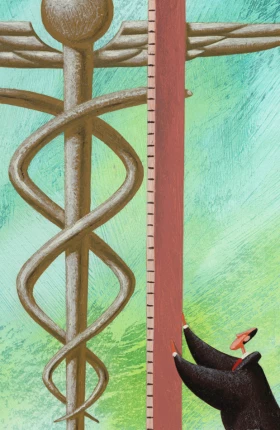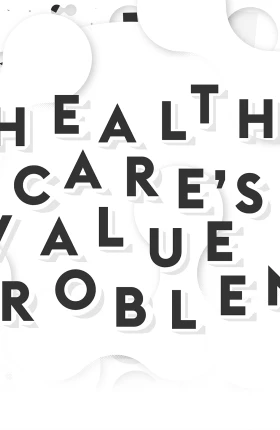Covid-19 is why measuring population health outcomes is needed now more than ever.
Healthcare systems have been largely designed around sickness. They tend to be reactive, aiming to cure disease rather than proactive, aiming to prevent disease by improving healthcare.
Evolution of value-based healthcare
Value based Healthcare as a model for health systems, aspires to improve outcomes relative to cost for all subsegments of our population, not only those with a specific disease. Such subsegments can be women with a high risk of breast cancer, or socio-economically deprived who have a higher risk of poor health. To address these health needs we must have a holistic view on what brings better health outcomes to our populations and must therefore consider the environment in which diseases develop or the preventive measures that could have limited their impact.
Value-based healthcare offers a model for healthcare systems to improve the overall health of their citizens. By measuring outcomes at two levels—whole-life and for specific sub-populations—targeted interventions can be implemented earlier, deliver better outcomes, and manage long-term costs.
Predict
Disparities in health outcomes are influenced by a wide range of factors, including lack of access to healthcare services, education, housing, transportation, food security, personal safety, local amenities, utilities, and financial resources. Addressing such disparities often requires measuring and assessing the social determinants of health and creating programs to help citizens maintain their health. Unfortunately, despite 80% of healthcare outcomes being attributed to such factors,
Improving a population’s long-term health outcomes requires a healthcare system transformation—moving from a reactive business model to a predictive one. Such a transformation requires robust capabilities, first to ascertain the likelihood of a disease developing quickly in certain populations, and then to identify the optimal, evidence-based interventions to employ at each stage of a disease.
Mass screening programs are among the early methods used to predict and preemptively treat diseases. Yet, such programs are not always an exact science. Data from Denmark finds that for every 2,000 women screened for breast cancer, one woman’s life is saved while 10 others are harmed due to unnecessary removal of cancerous cells, cells that would never have progressed in the patient’s lifetime.
Genomic sequencing and artificial intelligence (AI) promise a more accurate way to predict a patient’s risk of developing disease. In 2019, Abu Dhabi’s Department of Health announced its Genome Program, which combines DNA sequencing with artificial intelligence to create a database of 100,000 citizens’ genomes. The database genomes can be analyzed to identify changes in genes, chromosomes, and proteins that lead to genetic disease. Public health officials will use this information to predict the likelihood of genetic disease for specific populations and then to intervene at much earlier stages of the disease. The Genome Program also aims to strengthen knowledge of the Arab genetic makeup to address the specific health needs of this population.
Population risk stratification identifies which segments of the population might be at risk of disease and where interventions could make the biggest difference. By predicting the likelihood of disease early, the ability to intervene in an evidence- and value-based way is far better. The benefit of such an approach is that health systems have clearer insight into where resources should be allocated to get the best outcomes for their populations, thus making health systems more resilient over the long term.
Prevent
With more accurate predictions, healthcare systems can gradually move from reactive-curative business models to predictive-preventive models.
Armed with robust data about what could happen, health systems are equipped to design, test, and launch interventions that improve or maintain the health of populations. Both primary and secondary preventions are integral to improving outcomes. In other words, for people living with long-term conditions, community-based preventive interventions can reduce the need for more invasive and costly hospital stays.
A good example comes from Oak Street Health in Chicago. The clinic serves older adults residing in low-income, underserved urban neighborhoods. Oak Street patients have a higher risk of hospital admittance due to underlying health conditions and limited availability to healthcare services. Hospital admissions can be costly as they often occur at a stage where the patient’s health has grown significantly worse. Investing in prevention leads to better outcomes for patients and fewer resources consumed, resources that can be allocated to other populations.
Oak Street Health’s mission is to build a primary care delivery platform that addresses two of healthcare’s most pressing challenges—rising costs and poor outcomes. The goal is for patients to become more engaged in their healthcare and therefore more motivated to take preventive actions to maintain their wellbeing . Oak Street Health wants to create a virtuous cycle in which keeping patients happy and healthy leads them to maintain their health, improve their outcomes, and lessen the need for costly curative services in hospital settings.
“Oakies,”as they are called, use a variety of preventive interventions, such as embedding their clinics in high footfall areas, providing patient transport between home and primary care visits, ensuring patients’ overall well-being (beyond health), and spending more time with patients during primary care visits.
Oak Street Health also identifies potential risks by triaging patients into one of four tiers—age, comorbidities, recent utilization patterns, and degree of social support. This helps identify the optimal interventions for each population and to allocate the right resources to maintain patient health.
As a result of this approach, Oak Street Health’s customer loyalty score reached 92%, indicating high-patient satisfaction. And both hospital admissions and emergency department admissions fell by 51% and readmission rates within 30 days of discharge dropped by 42%.
Another example comes from the National Health Service (NHS) in England where low-cost prevention is improving long-term outcomes. Case in point, the high price tag for poor oral health, which costs the NHS £3.4 billion annually. Citizens in deprived areas do not routinely go to the dentist. However, they routinely visit community pharmacies to pick up medicine. With this in mind, the NHS launched a new initiative in which pharmacists offer oral health advice to customers waiting for their medicine. As a result, 66% of customers who heard the pharmacist’s advice said they would “definitely” change their oral health habits in the future.
Plan
People living in densely populated and heavily polluted areas have higher-than-average mortality risk. Many have weakened immune systems and are at considerable risk of respiratory disorders and heart disease.
Several countries are organizing interventions to improve the health of their populations. For example, low-income populations in Canada are significantly less likely to participate in cancer screenings, which leads to worse healthcare outcomes either through delayed or missed diagnoses.
Healthcare systems are also strengthening their population-planning capabilities. The plan is to create “cradle-to-grave” interventions for specific populations across the different healthcare determinants—from access to health services, to improved housing, to better job opportunities. Population planning requires collaboration within healthcare systems and within a broad spectrum of participants, including social workers, community leaders, healthcare providers, government regulators, and legislative bodies.
On a related topic, the World Health Organization (WHO) launched a global action plan called “best buys” for the prevention and control of non-communicable diseases. The plan offers recommendations to policymakers on ways to achieve cost-effective interventions. Among the recommendations are tax increases, advertising restrictions on tobacco and alcohol, and public information on diet, physical activity, and salt intake.
The predict-and-prevent phases can be spent creating “lifetime plans” on a host of topics. Obesity, for example. Its causes are complex and can include one or more of the following: genetic and physiological factors, growth and development in early life, education, eating behaviors, and physical activity. Add limited access to affordable and healthy food options in certain neighborhoods and obesity is no longer presumed to be caused by a person’s lack of will power.
Populations at risk of obesity are identified throughout the predict-and prevent phases and intervention plans are initiated as necessary. All interventions are evidence-based, which means they occur at the place and time intermediation is needed. Lifetime plans are also useful in forecasting value-based projections of the ultimate health and cost benefits.
International forums such as the Global Innovation Hub for Improving Value in Health, or The Hub, were established by G20 countries. These forums are important for sharing information with nations about measuring long-term value and encouraging cross-learning among multiple stakeholders, including the public and private sectors, civil societies, community-based organizations, and academia.
Employing value-based healthcare to improve population health
By gathering cradle-to-grave data on population outcomes, healthcare systems can develop more resilient policies and interventions and institute more effective resources. As a result, patients can expect improved services with better outcomes and higher quality of life.
The sooner healthcare systems implement “Predict, Prevent, and Plan,” the better the outcomes as more citizens live longer, healthier lives. Our framework provides three main areas healthcare systems need to engage, both to measure and improve population outcomes.
- Predict. Healthcare systems will take deep, data-driven approaches, not only to identify at-risk population segments sooner but also to intervene more effectively.
- Prevent. Healthcare providers will avoid exacerbating pre-existing diseases by improving care in the community and thereby reducing demand for expensive and invasive hospital visits.
- Plan. Healthcare systems and providers will collaborate with stakeholders across sectors to identify the socioeconomic causes of poor outcomes. In doing so, changes can be made to physical and social environments that improve outcomes for all.
Three Steps to Value-Based Prevention
Predicting disease at population levels should be a priority for all healthcare systems. In addition to education and screening programs, health systems are harnessing genomic and population-based screenings to predict which population groups are most at risk of developing disease. The information informs where health prevention and intervention resources are best allocated.
The key to improving overall population outcomes is to prevent the spread of existing and future diseases. By engaging patients in their homes and in community settings, healthcare systems remove barriers to healthcare and, in some cases, reduce the need for hospital admissions.
Most successful healthcare systems have a deep understanding of socioeconomic factors and their impact on health. Understanding and acknowledging the link between socio-determinants of health and specific interventions is necessary for health systems to maintain the wellbeing of their populations.
Delivering Value
Evidence-based healthcare systems work closely with stakeholders from a wide range of sectors. Top healthcare systems develop plans conducive to delivering better population outcomes in the long term and are highly engaged with stakeholders to make sure all solutions deliver value. Ask healthcare professionals what their ultimate target is and the answer is almost always the same: To deliver value.









